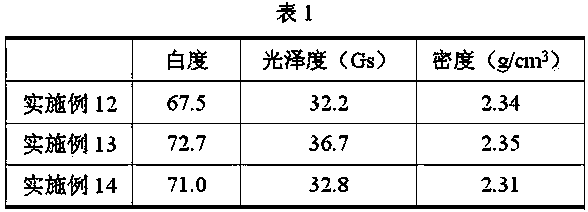Alkali silicate glass frit, zirconium frit opaque glaze, and preparation methods of the alkali silicate glass frit and zirconium frit opaque glaze
A technology of glass frit and alkali silicate, which is applied in the fields of alkali silicate glass frit, opacified glaze and its preparation, zirconium opacified glaze and its preparation, and can solve the problem of reducing the production cost of opacified glaze and reducing raw materials Use types, high production costs and other issues to achieve the effect of reducing the burden of post-processing, reducing the types of raw materials, good environment and social and economic benefits
- Summary
- Abstract
- Description
- Claims
- Application Information
AI Technical Summary
Problems solved by technology
Method used
Image
Examples
Embodiment 1
[0041] The frit is made from waste silica gel and soda ash, wherein the waste silica gel contains 5-12wt% zirconia and the rest is silica. In the raw materials, the amount of waste silica gel and soda ash meets the requirement of introducing SiO 2 and Na 2 The molar ratio of O is 75:25, which is 3:1. The frit is prepared as follows:
[0042] 1. Take waste silica gel and soda ash in proportion, mix them evenly, and heat them to 1280°C in an electric furnace or kiln to melt them;
[0043] 2. Quench the molten glass with water, filter it dry, and dry it at 120°C to obtain a frit. The resulting frit can be directly used as a raw material for producing water glass (commonly known as sodium silicate), and can also be used as a raw material for opacified glaze.
Embodiment 2
[0045] The frit is made from waste silica gel and soda ash, wherein the waste silica gel contains 5-12wt% zirconia and the rest is silica. In the raw materials, the amount of waste silica gel and soda ash meets the requirement of introducing SiO 2 and Na 2 The molar ratio of O is 67:33, except that waste silica gel and soda ash are heated to 1250° C. for melting, other steps for preparing frit are as in Example 1.
Embodiment 3
[0047] The opaque glaze is made from waste silica gel, soda ash, clay and albite, wherein the waste silica gel contains 5-12wt% zirconia and the rest is silica. In the raw materials, the amount of waste silica gel and soda ash meets the requirement of introducing SiO 2 and Na2 The molar ratio of O is 75:25, that is, 3:1, and the amount of clay is 1% of the total amount of frit, and the amount of albite is 5% of the total amount of waste silica gel and soda ash. Waste silica gel and soda ash are added in the form of frit, and the method for preparing frit glaze is as follows:
[0048] 1. Take waste silica gel and soda ash in proportion, mix them evenly, and heat them to 1280°C in an electric furnace or kiln to melt them;
[0049] 2. Quench the molten glass with water, filter it dry, and dry it at 120°C to obtain a frit;
[0050] 3. Mix the frit with clay and albite for ball milling (material: water: ball mass ratio is 1:0.7:1.5);
[0051] 4. Glaze the ceramic body by dipping...
PUM
 Login to View More
Login to View More Abstract
Description
Claims
Application Information
 Login to View More
Login to View More - R&D
- Intellectual Property
- Life Sciences
- Materials
- Tech Scout
- Unparalleled Data Quality
- Higher Quality Content
- 60% Fewer Hallucinations
Browse by: Latest US Patents, China's latest patents, Technical Efficacy Thesaurus, Application Domain, Technology Topic, Popular Technical Reports.
© 2025 PatSnap. All rights reserved.Legal|Privacy policy|Modern Slavery Act Transparency Statement|Sitemap|About US| Contact US: help@patsnap.com

